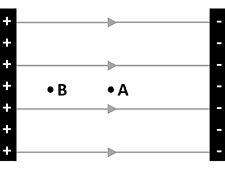
Electric potential difference
Variant i Interactive tutorial lecture Other Variants Dynamics first
Students are guided in developing an interpretation of electric potential difference.
Topics Electricity and magnetism / Electrostatics: fields, representations, electric fields, electric potential difference, electric potential energy, field lines, forces, internal vs. external forces, point charges, work, and work-energy theorem
Materials
Materials by the UW team
- Clicker Questions Only


- Instructor Guide


- Pretest



- Pretest for LMS



- Exam Questions



- Equipment List

Tutorial details
Section I: Electric fields & forces
This section serves as a review of electric fields and forces. Students use electric field lines to determine the direction of the field and relative field strength. They then determine the direction of the force on a point charge in a field.
Section II: Work & energy
Students consider work done by an external object on a charged particle in a uniform electric field. They find the work done on the particle as it travels between two points, then consider cases where the direction of motion is reversed and the charge on the particle is modified.
Section III: Electric potential difference
In this section, students consider the change in potential energy of a plate/particle system, $\Delta U_{elec}$. They determine that $\Delta U_{elec}$ changes when the magnitude of the charge on the particle decreases, but the quantity $\frac{\Delta U_{elec}}{q}$ remains the same. This demonstrates the usefulness of this quantity, which we call electric potential difference. Students find that the electric potential difference between two points depends on neither the magnitude nor the sign of the charge of the particle used to measure it.
Section IV: Supplement
In the supplement, students consider the case where no external work is done on the +q charge as it travels between two points.
For instruction tips, login or register as a verified educator to see the Instructor Guide.
Prerequisites
Prerequisite tutorials
The Charge tutorial is a prerequisite to Electric potential difference.
Other prerequisites
Students need to have studied electric fields.
Coming Soon! We hope to release the discussion section on each tutorial soon.

